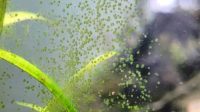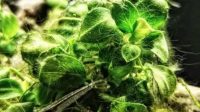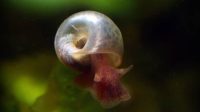In aquascaping, you may find some issues that infected our beloved tank. Starting from fish problems to equipment problems. Algae invasion is a common problem that usually strikes the aquariums of many aquarists.
Many different types of algae are often seen in aquaria, including Brown Algae (Diatomaceae), Green Spot Algae (Choleochaete), Green Dust Algae, Green Fuzz Algae (Oedogonium), Green Beard Algae, Red Spot Algae, Black Brush Algae (Audouinella sp.), Green Water, Water Silk (Spirogyra), Green Thread Algae, Hair Algae (Rhizoclonium), Staghorn Algae (Compsopogon sp.), Blue-Green Algae – BGA (Cyanobacteria), Fuzz Algae and Blanked Weed (Cladophora).
A focus point that we can talk about wholly at this time is the ‘Green Dust Algae.’ Keep reading, and do not move your display from this page.

What Is Green Dust Algae?
These algae types are primarily found in an aquarium that is new to set-ups. They usually stick on the glass, hard and smooth aquarium decorations, and equipment such as stones, woods, and aquatic plants.
In fact, green dust algae (GDA) are zoo-spores. They establish a green film dusty-looking on the glass; in a critical case, these algae could cover the whole of the tank glass.
The aquarium algae species actually loves attaching to the glass, so the Germans named these algae “Grüne Scheibenpest,” which means green glass plague. Their growth is faster; when they begin to develop, you will see them immediately turning like a green carpet layer with a thicker size.
The algae clipping on the glass usually has a lighter green color than the algae forms that stick on the equipment or hardscapes. It is caused by the lights hitting the algae from both sides of the aquarium wall, making it seem brighter tint.
How To Identify The Green Dust Algae?
These aquatic algae types only clip on the glass without changing the color of the water. The water should not be unchanged when wiping the sticking algae with your finger. The GDA will float for 30-90 minutes before sticking itself again to the glass.
Many aquascapers are sometimes made to be confused with green spot algae because they look relatively identical. But, when they are compared by their characteristics, the distinctions become clear.
The green spot algae grow to form unique circular shapes between one another that slowly merge together. To ensure the difference between both of them, use your finger. Touch them softly; if they are easy to lift off, that is actually green dust algae. If they are stubborn, you have another one.

What’s Causes The Green Dust Algae Thrive In The Tanks?
Unfortunately, there are still no exact reasons universally agreed upon why the green dust algae could thrive in the aquarium. However, there is a reason why these algae bloom in the tanks.
According to information from some experts, overlighting the aquarium may lead to the growth of these algae types. However, it’s not a precise reason, but obviously, these aquarium algae prefer to attach in brighter places, such as in front of the glass wall.
The second theory is that the spores of green dust algae are introduced into your aquarium by riding on the bodies of fish, aquatic plants, hardscapes, or equipment from an infected tank. Then, they wait for the perfect time to spread out in your tank.
The third is caused by the biological fact that the aquarium is still immature. This thing makes the unbalanced substances in the water parameters that help push the algae to bloom.
Fourth, the GDA may appear by significant changes in the planted tank. For example, drastic changes in the equipment or plant mass (e.g., after an excessive trimming leaves session).
Fifth, some aquarists tell us that green dust algae infect their tank and contain a ton of dissolved nitrogen in the water caused by magnesium nitrate or urea, which leads these algae to grow (generally happens in a tank with high NO3 > 10 ppm).
Sixth, the accumulation of organic debris on the aquarium’s bottom can also help these algae develop.
Is The Green Dust Algae Harm Your Fish And Plants?
Nope, the green dust algae are not dangerous for fish. A particular fish can still be healthy and alive, although kept in the aquarium, which is covered by it. Even a bristlenose pleco will happily inhabit the tank that is full of it.
How about the plants? An aquarium hobbyist tells us his experience; he said his aquatic plants’ look isn’t particularly disturbed by these algae. His plants were coated by it for a couple of months and are still alive. Once the green dust algae are removed, they grow healthy again.
How To Stop The Green Dust Algae Grow In Your Tank?
The green dust algae cover your aquarium wall, plants, equipment, and soil. How do we fight and stop them from blooming again? We will show you how to get rid of green dust algae from your beloved tank.
There are some methods that can help you gain success in anticipation of the growth of the GDA. Below are the ways:
Balancing The Water Nutrients
Like the statement above, one of the problems with green dust algae growing is high nitrate dissolved in the water. So, grab your aquarium test kit and check all the required nutrients of your aquarium plants, such as pH, CO2, phosphate, etc.
If there is an imbalance of elements, fix it immediately. It is a good list that could become a reference to create an environment with the balanced nutrition which is preferred by your aquatic plants:
- CO2: 20 – 30 mg/l
- Nitrate (NO3): 10 – 25 mg/l
- Potassium (K): 5 – 10 mg/l
- Phosphate (PO4): 0.1 – 1 mg/l
- Magnesium (Mg): >10 mg/l
Stopping The Green Dust Algae Spores To Develop With UV Sterilizer
The spores are incredibly tiny, so they can not be seen with the naked eye. But, if you abandon them there, they will mutate and produce themselves more and more until coating all parts of the aquarium.
Using a UV sterilizer may become a powerful way to kill the spores. This innovative device can hit all tiny creatures that are floating in aquarium water using light beams. You can also combine this tool with a 100-micron polishing pad in the filter to catch them there. It will increase the effectiveness level to stop the algae from developing.

Remove The Green Dust Algae Manually
This way is our favorite method, but we may spend more time fighting with them. Many fishkeepers also gain success by manually removing the green dust algae. Here is the trick:
The GDA is assumed to have a life cycle, so they will come back again if you clean them up in the early days. So, it would be best if you wipe them when they are old.
They usually take about four weeks to complete their life cycle. After four weeks, reduce the water level until the algae are exposed around 3-4 inches above the waterline. Once the water is low, clean the algae that attaching to the glass with paper towels. Be careful when brushing them; do not let any piece fall into the water.
After that, carefully pick up any equipment in the aquarium, such as the powerhead or heater outside the aquarium. Next, clean it from the algae using unused cloth.
To eliminate any remaining spores on the glass, take another fabric, spray 3% hydrogen peroxide onto it, and then wipe it to over cleaned sections. After that, fill up the tank with clear fresh water. Distilled water is very suggested when filling up new water in your tank. It is free from dangerous metal elements such as iron and manganese that are risky to water quality. You can buy an RO water kit for home aquaria on the trades to generate it by yourself. This will save your funds significantly than buying bottled distilled water in the stores.
Adding Algae Eaters
A simple way to fight green dust algae is using algae eaters. Common freshwater snails like Zebra Nerite are effective in cleaning up green dust algae, primarily at low levels. However, in many cases, they often eat algae according to their desires and leave odd traces in the aquarium, as shown in the picture below.

But what if the algae spreads out and coats almost all places in the aquarium? Indeed, you need a giant algae eater to control it.
Bristlenose plecos are the correct answer; they are freshwater fish with a big appetite for consuming algae, mainly the GDA and green hair algae. Many aquarists use these most popular algae eater types to do away with it without wetting their hands.
You can integrate the manual removal method with bristlenose pleco; you will have a great punch to defeat the green dust algae in your tank. Ensure, do not make your fish are starving when the algae are gone, giving their favorite food such as zucchini or algae wafers will make them continue their duties happier.
Other Methods To Eliminate The Green Dust Algae
Maybe you want to try another easy way to cut the growth of green dust algae before using all the methods above. The first is to perform a blackout between 3-5 days on your tank. This thing might be preventing them from spreading out.
Use a thick blanket to cover the tank, do not overfeed your fish, and do not add fertilizers during the treatment. But if you keep a shrimp tank, you may unfeed your pets. Turn off the CO2 injection if you apply it, and supply more oxygen by installing an air pump into your tank.
Once the treatment session is complete, make sure to make your fish adapt to the normal environment by opening a half part of your tank and leaving it like this for around thirty minutes. After that, remove the blanket entirely and leave it like that for another thirty minutes before turning on the aquarium lamp.
Next, clean all remaining algae on the objects, equipment, and wall glass. Then, do a water change of around 30%-50% depending on the conditions. The last step is installing any equipment and objects into the aquarium, switching on the lamp and carbon dioxide, and adding some doses of fertilizers.
The second uses a liquid algae remover or liquid carbon, such as “Seachem Flourish Excel,” that can be purchased from fish stores or online markets. It’s slightly effective in decreasing the growth of the spores. This liquid works well in mild cases.
Conclusions
The green dust algae are one of the common problems that attack the new aquarium setup. Some new tank keepers probably quit their hobby because of this issue.
But do not be static; for every problem that comes to your tank, there must be a way to solve it. Always learn more and more about aquascaping knowledge to prevent any lousy condition from happening to your tank, so keep on fishkeeping.





